National Grid’s latest energy scenario modelling suggests a potential major increase in demand-side response (DSR) provided by UK businesses.
The electricity system operator has also increased its projections of storage capacity, though revised down long-term solar growth across scenarios that could play out, depending on the policy decisions and market developments in the medium to long-term.
DSR could quickly double
Two of its 2019 Future Energy Scenarios outline a doubling of ‘load’ DSR (turning on or off, up or down) to 2GW by 2025. Those models are based on a higher penetration of renewables and the UK taking more urgent steps to mitigate climate change. Under the ‘community renewables’ scenario, load DSR triples from 1GW today to 3GW by 2027, hitting that level by 2029 in the ‘two degrees’ scenario.
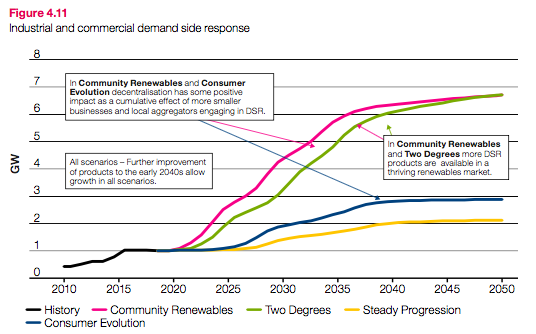
Load DSR also increases in the other two models – ‘steady progression’ and ‘consumer revolution’ – but at a slower rate.
National Grid ESO said DSR “has an important role to play as one of the tools that support flexibility in a future energy system” and that the “notable upturn by 2025” in its models comes about “as the market framework and products become more streamlined”.
However, the Future Energy Scenarios report illustrates how load DSR has flatlined for the last four years.
Batteries charge
National Grid said 500MW of storage has come online in the last year, mostly short duration batteries, though including some novel forms, such as Highview Power’s 5MW/15MWh liquid air energy storage facility at Bury.
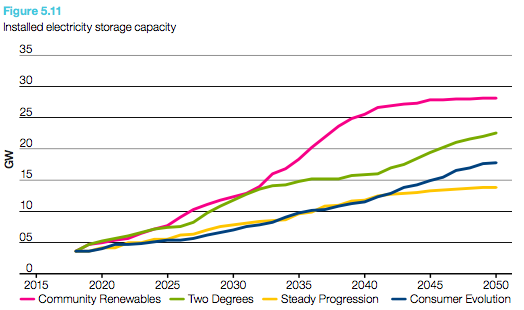 “This rapid development of projects in the past 12 months has led us to increase our projections of storage growth in the 2020s in most scenarios, as we see the development of a robust project pipeline,” states the document.
“This rapid development of projects in the past 12 months has led us to increase our projections of storage growth in the 2020s in most scenarios, as we see the development of a robust project pipeline,” states the document.
Under ‘community renewables’ and ‘two degrees’ scenarios, UK storage capacity reaches around 7.5GW by 2025, an increase of roughly 50 per cent, and increases to around 13GW by 2030 as increased penetration of intermittent renewables creates greater system flexibility requirements.
Electric vehicles for grid services
The models for battery storage do not include those within electric vehicles. But National Grid said these could also be a significant source of flexibility.
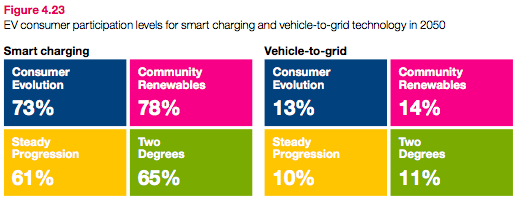 In line with FES 2018, National Grid’s scenarios maintain that only 2 per cent of electric vehicles will be used to provide grid services (V2G) by 2030. However, between 10 and 14 per cent could do so by 2050, equating to gigawatts of flexibility and offsetting 85 per cent of EV demand at peak.
In line with FES 2018, National Grid’s scenarios maintain that only 2 per cent of electric vehicles will be used to provide grid services (V2G) by 2030. However, between 10 and 14 per cent could do so by 2050, equating to gigawatts of flexibility and offsetting 85 per cent of EV demand at peak.
Solar dip
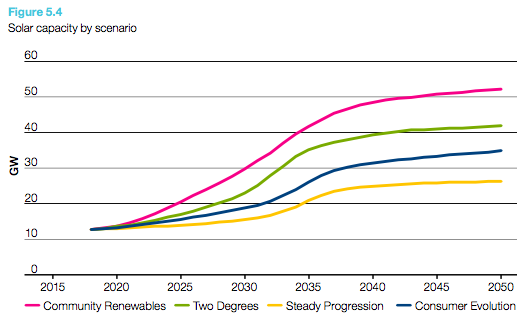 National Grid said it has revised down maximum penetration of solar PV across its scenarios following stakeholder feedback. However, even its most pessimistic scenario models a doubling of capacity to around 25GW by the mid 2030s.
National Grid said it has revised down maximum penetration of solar PV across its scenarios following stakeholder feedback. However, even its most pessimistic scenario models a doubling of capacity to around 25GW by the mid 2030s.
For the next few years, growth in solar PV remains depressed under National Grid’s models, picking up again from the early 2020s as cheaper batteries improve co-location economics.
FES 2019 contains a broad number of models and scenarios across multiple industries and energy sectors. Read the full report here.
The Energyst is surveying end users for views on demand-side response and battery storage. Let us know if the market is working for you via this short survey – and tick the box at the end if you would like to attend the associated conference. Take the survey.
Related stories:
DSR providers urge National Grid to go faster, Ofgem to go slower
National Grid to bring wind and solar into FFR, details balancing system overhaul
Can the Balancing Mechanism offset FFR price erosion?
National Grid outlines plans to bring all flex providers into Balancing Mechanism
National Grid models major solar growth
As solar generation makes history, National Grid starts to feel the burn
National Grid slashes long term estimates for battery storage
Net zero: Let DNOs install fatter wires to handle EVs and electric heat
Vehicle-to-grid: Are we nearly there yet?
EV boom no sweat, says National Grid
Faraday Grid: We come from the future to stabilise the power system
Click here to see if you qualify for a free subscription to the print magazine, or to renew.
Follow us at @EnergystMedia. For regular bulletins, sign up for the free newsletter.



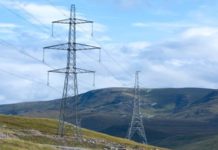
All four of National Grid’s future scenarios for the energy market model a significant increase in the volume of flexibility that the Grid will be procuring from energy users through balancing services.
The scenarios, in which the UK is able to meet its 2050 Net-Zero emission target, show close to a six-fold increase in DSR volume compared to the current levels. The Net Zero sensitivity scenario analysed by the Grid predicts the need for DSR volume at a level as high as 13GW (approx. 13 times higher than currently).
This creates huge opportunities for energy intensive businesses. We mustn’t underestimate the role end users will play in providing flexibility to the grid, enabling the integration of more renewables and ensuring additional capacity to accommodate the increasing energy demand driven, for example, by things like the mass uptake of electric vehicles.